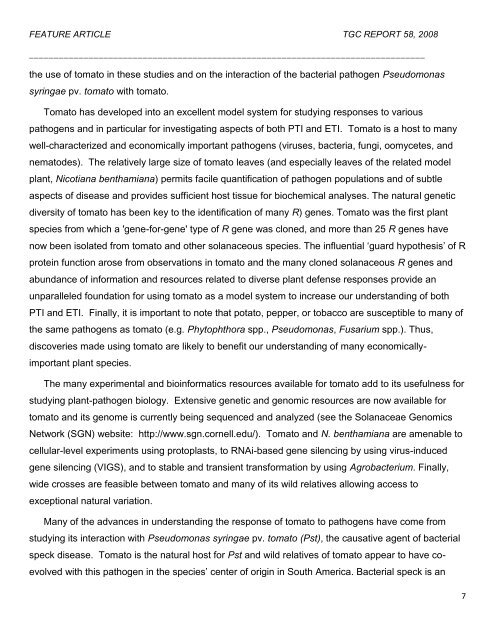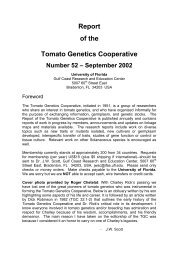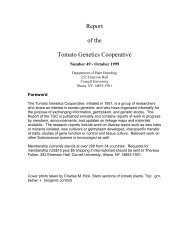Report of the Tomato Genetics Cooperative Number 58
Report of the Tomato Genetics Cooperative Number 58
Report of the Tomato Genetics Cooperative Number 58
You also want an ePaper? Increase the reach of your titles
YUMPU automatically turns print PDFs into web optimized ePapers that Google loves.
FEATURE ARTICLE TGC REPORT <strong>58</strong>, 2008<br />
________________________________________________________________________________<br />
<strong>the</strong> use <strong>of</strong> tomato in <strong>the</strong>se studies and on <strong>the</strong> interaction <strong>of</strong> <strong>the</strong> bacterial pathogen Pseudomonas<br />
syringae pv. tomato with tomato.<br />
<strong>Tomato</strong> has developed into an excellent model system for studying responses to various<br />
pathogens and in particular for investigating aspects <strong>of</strong> both PTI and ETI. <strong>Tomato</strong> is a host to many<br />
well-characterized and economically important pathogens (viruses, bacteria, fungi, oomycetes, and<br />
nematodes). The relatively large size <strong>of</strong> tomato leaves (and especially leaves <strong>of</strong> <strong>the</strong> related model<br />
plant, Nicotiana benthamiana) permits facile quantification <strong>of</strong> pathogen populations and <strong>of</strong> subtle<br />
aspects <strong>of</strong> disease and provides sufficient host tissue for biochemical analyses. The natural genetic<br />
diversity <strong>of</strong> tomato has been key to <strong>the</strong> identification <strong>of</strong> many R) genes. <strong>Tomato</strong> was <strong>the</strong> first plant<br />
species from which a 'gene-for-gene' type <strong>of</strong> R gene was cloned, and more than 25 R genes have<br />
now been isolated from tomato and o<strong>the</strong>r solanaceous species. The influential ‘guard hypo<strong>the</strong>sis’ <strong>of</strong> R<br />
protein function arose from observations in tomato and <strong>the</strong> many cloned solanaceous R genes and<br />
abundance <strong>of</strong> information and resources related to diverse plant defense responses provide an<br />
unparalleled foundation for using tomato as a model system to increase our understanding <strong>of</strong> both<br />
PTI and ETI. Finally, it is important to note that potato, pepper, or tobacco are susceptible to many <strong>of</strong><br />
<strong>the</strong> same pathogens as tomato (e.g. Phytophthora spp., Pseudomonas, Fusarium spp.). Thus,<br />
discoveries made using tomato are likely to benefit our understanding <strong>of</strong> many economically-<br />
important plant species.<br />
The many experimental and bioinformatics resources available for tomato add to its usefulness for<br />
studying plant-pathogen biology. Extensive genetic and genomic resources are now available for<br />
tomato and its genome is currently being sequenced and analyzed (see <strong>the</strong> Solanaceae Genomics<br />
Network (SGN) website: http://www.sgn.cornell.edu/). <strong>Tomato</strong> and N. benthamiana are amenable to<br />
cellular-level experiments using protoplasts, to RNAi-based gene silencing by using virus-induced<br />
gene silencing (VIGS), and to stable and transient transformation by using Agrobacterium. Finally,<br />
wide crosses are feasible between tomato and many <strong>of</strong> its wild relatives allowing access to<br />
exceptional natural variation.<br />
Many <strong>of</strong> <strong>the</strong> advances in understanding <strong>the</strong> response <strong>of</strong> tomato to pathogens have come from<br />
studying its interaction with Pseudomonas syringae pv. tomato (Pst), <strong>the</strong> causative agent <strong>of</strong> bacterial<br />
speck disease. <strong>Tomato</strong> is <strong>the</strong> natural host for Pst and wild relatives <strong>of</strong> tomato appear to have co-<br />
evolved with this pathogen in <strong>the</strong> species’ center <strong>of</strong> origin in South America. Bacterial speck is an<br />
7





